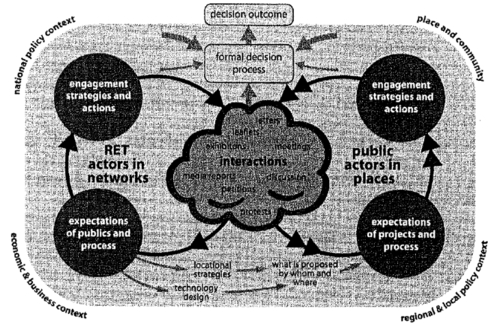From the proposed literature, it has been decided to outline the concepts of two publications.
Symmetries, Expectations, Dynamics and Contexts: A Framework for understanding public engagement with renewable energy projects. Walker et al, 2011
A lot of times, when the implementation of a RET (Renewable Energy Technology) project does not meet with approval of the public, the attention is set on what are the characteristics of the project that cause opposition while there are many other factors that can influence the success of the initiative. These factors are related to the interaction between the RET actors and the public and how decision processes are structured and enacted. For this reason the authors provide a framework that aims to explain how this interaction is made.
Such framework is identified with four consecutive characteristics:
- Symmetry between the Publics and RET Actors.
The behaviour of both parts play an important role in development of the project. A distinction is made by conceiving RET actors in networks and Public actors in places. Reality shows that it is not usually as black and white but, for example, people can form coalitions that share land, interest or both. The interactions between these two actors are regarded as potentially significant in shaping how the dynamics of local responses evolve and how different actorts learn, react and strategically behave in relation to each other.
- Expectations from both sides
Both actors have expectations of the project. In the case of the public, they have expectations about the form and impact of the project, about the project developers, about the proves and about how a proper distribution of the benefits should be. On the side of the RET actors, also there are many expectations about the public reaction to their project and how they ought to operate and engage with them. These RET actors’ expectations are drawn from personal and others’ experiences and can have an effect on their disposition to communicate and dialogue with the public, which at the same time has an effect on the development of the project.
- Dynamic interaction
The interaction between these two parties is regarded as dynamic or circular. Initial expectations shape engagement actions, which feed interactions, which then shape expectations, and so on.
- Developed in a context
The context of policy, regulation, geography and history has a very big influence on the steps of the project. The nature of the communities involved in terms of their socio-demographics, levels of prosperity, mix of long-established and more recent incoming residents, and lebels of social capital can also be significant in explaining patterns of expectation and engagement.
Figure 1 shows how the graph of the framework looks in the end.
The article gives an approach of the role of the public in this kind of projects. Although it is centered in RET projects, the given information can be useful in other fields and it is very applicable when designing the mobility system in Texel. In the mobility sector, there is a growing tendency of implying the public during the design phase of a mobility plan. It is proven that by doing so, the projects have greater potential of success as the actors related to it feel more engaged and the sense of ownership increases (Artur Gil, 2011).
Grassroots innovations in community energy: The role of intermediaries in niche development. Hargreaves et al, 2013
The focus of this article is to study how intermediary actors engage with the diverse forms of the so-called grass-roots innovations. A grass-root innovation is an initiative which has its origin in a group of people that have common interest in challenging and attempting to replace unsustainable aspects of a society. These type of innovations, however, have a lot of times difficulty in even surviving and keeping forward.
According to the authors, intermediaries are key figures in helping a small-scale, radical innovation to advance. They have three clear roles:
- Aggregating lessons from across multiple local projects
- Establishing an institutional infrastructure for the innovation niche as a whole
- Framing and coordinating action
By doing so, intermediary actors open space in different contexts (local, policy, market, social...) and strengthen the project supporting and respecting the different voices of the initiators.
Texel’s plans for being more sustainable do not come entirely from popular initiatives and so, these cannot be defined as grass-root innovations. However, it is interesting to see how the figure of the intermediaire fits within the public driven projects and how it can contribute to bring the initial ideas an innovation to success.
